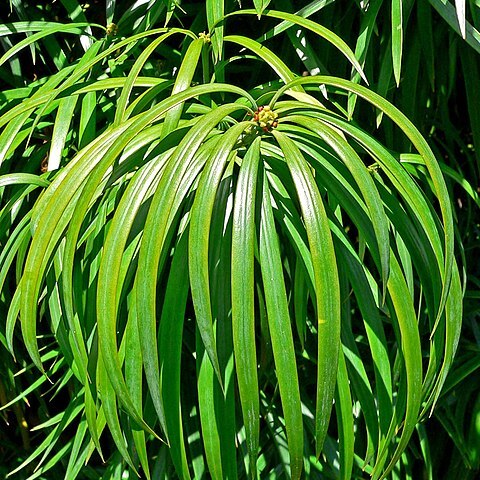Straight tree up to 35 m high and attaining a girth of up to 6 m. Bark dark grey to khaki-coloured, in older specimens longitudinally fissured, usually defoliating in long narrow strips, occasionally defoliating in large sheets. Branchlets pale green with grooves from decurrent leaf bases. Terminal buds 3-5 mm in diameter; outer bud scales narrowly triangular tapering to a ± linear tip 0.5-1 mm long, 7-10 mm long and 1.4-1.9 mm wide at the base, upper half often rolled into a spiral. Leaves spirally arranged to sub-opposite, often crowded in upper parts of shoots and subverticillate, ± pendulous, dark green and glossy above, straight to slightly falcate, very narrowly lanceolate-elliptic with widest point generally just below the middle, almost parallel-sided from there downward to about the lower third, then narrowing gradually into a short petiole, tapering very gradually from about the middle upwards to an acuminate tip; adult leaves(5-)9-12(-17) cm long and (5-)6.5-8(-10) mm wide; juvenile leaves up to 22 cm long and up to 26 times as long as broad; midrib raised on lower surface, on upper surface slightly raised, at least in lower 2/3; margins slightly reflexed; stomata confined to lower surface, arranged in 25-35 ± distinct longitudinal rows on either side of midrib. Male cones solitary or in groups of 2-5, sessile or on very short stalks, (1.2-)1.5-1.8(-2) cm long, elongating to 4 cm and more after shedding pollen, (4-)4.5-5(-6) mm in diameter; outer sterile scales at base trullate-ovate to narrowly so, often with a ± terete tip 0.25-0.75 mm long, strongly but bluntly keeled, subentire to finely lacerate, about 4-5 mm long and 2-3 mm wide; terminal lobe of fertile scale widely ovate to ovate-triangular, lacerate to irregularly dentate, 0.7-1 mm long and 0.9-1.1 mm wide, pollen sacs 1.3-1.5 mm long and 0.6-0.7 mm in diameter. Female cones solitary on short naked stalks, receptacle clavate, glaucous, never fleshy, often not clearly demarcated from the stalk, length of receptacle and stalk together 4-12 mm, width of mature receptacle at top 3-6 mm, receptacle consists of two bracts of which only the terminal one is fertile. Seed ovoid-ellipsoid, narrowing towards the base, (1.2-)1.7-2.2(-2.5) cm long and (1.1-)1.4-1.8(-2.1) cm wide, olive-green; shell hard, leathery, gritty but never woody, 1.4-4 mm thick, with cavities up to 1 mm wide containing a pale yellow to white resinous deposit.
More
Monoecious, evergreen tree, 20-35 m high; bark grey, narrowly longitudinally fissured, flaking, forming plate-like scales and small ridges. Buds glabrous, pointed, slender, sessile. Twigs glabrous, stout, dull, grey. Stems angular or round. Leaves alternate, simple, sessile. Blade (50-)90-120(-170) x (5.0-)6.5-8.0(-10.0) mm, linear, lanceolate or oblong, apex acute and mucronate, base cuneate, margins revolute. Cones axillary, erect. Fruiting cones fleshy, glabrous, (12-)17-22(-25) x (11-)15-20(-21) mm, ellipsoid; receptacle green, slightly swollen. Rind smooth, leathery, yellow or green.
A canopy or emergent tree in montane evergreen rainforest, often on steep, rocky slopes; at elevations from 1,300-2,000 metres. Also found in coastal forests near sea level in the south of its range.


